Combined Effects of Confinement and Macromolecular Crowding on Protein Stability
Abstract
:1. Introduction
2. Results
2.1. Protein Confinement Increases Thermal Stability of Proteins
2.2. Additive Effects of Confinement and Crowding on Protein Stability
2.3. Crowding Enhances the Optimum Temperature of Confined Proteins
2.4. Crowder Concentration and Not Size Plays a more Significant Role on Protein Stability
2.5. Combined Effects of Confinement and Crowding on the Structural Stability of Proteins
3. Discussion
4. Materials and Methods
4.1. Materials
4.2. Encapsulation of Enzymes in Agarose Gels
4.3. Measurement of Enzyme Activity
4.4. Measurement of Enzyme Functional Stability
4.5. Measurement of Enzyme Structural Stability
Supplementary Materials
Author Contributions
Funding
Acknowledgments
Conflicts of Interest
References
- Ellis, R.J. Macromolecular crowding: Obvious but underappreciated. Trends Biochem. Sci. 2001, 26, 597–604. [Google Scholar] [CrossRef]
- Minton, A.P. The Influence of Macromolecular Crowding and Macromolecular Confinement on Biochemical Reactions in Physiological Media. J. Biol. Chem. 2001, 276, 10577–10580. [Google Scholar] [CrossRef] [PubMed] [Green Version]
- Zhou, H.-X. Protein folding in confined and crowded environments. Arch. Biochem. Biophys. 2008, 469, 76–82. [Google Scholar] [CrossRef] [PubMed] [Green Version]
- Kuznetsova, I.; Turoverov, K.; Uversky, V. What Macromolecular Crowding Can Do to a Protein. Int. J. Mol. Sci. 2014, 15, 23090–23140. [Google Scholar] [CrossRef] [PubMed] [Green Version]
- Zhou, H.-X. Influence of crowded cellular environments on protein folding, binding, and oligomerization: Biological consequences and potentials of atomistic modeling. FEBS Lett. 2013, 587, 1053–1061. [Google Scholar] [CrossRef] [PubMed] [Green Version]
- Simpson, L.W.; Good, T.A.; Leach, J.B. Protein folding and assembly in confined environments: Implications for protein aggregation in hydrogels and tissues. Biotechnol. Adv. 2020, 42, 107573. [Google Scholar] [CrossRef] [PubMed]
- Shendi, D.; Marzi, J.; Linthicum, W.; Rickards, A.J.; Dolivo, D.M.; Keller, S.; Kauss, M.A.; Wen, Q.; McDevitt, T.C.; Dominko, T.; et al. Hyaluronic acid as a macromolecular crowding agent for production of cell-derived matrices. Acta Biomater. 2019, 100, 292–305. [Google Scholar] [CrossRef]
- Shahid, S.; Hasan, I.; Ahmad, F.; Hassan, M.I.; Islam, A. Carbohydrate-Based Macromolecular Crowding-Induced Stabilization of Proteins: Towards Understanding the Significance of the Size of the Crowder. Biomolecules 2019, 9, 477. [Google Scholar] [CrossRef] [Green Version]
- Hasan, S.; Isar, M.; Naeem, A. Macromolecular crowding stabilises native structure of α-chymotrypsinogen-A against hexafluoropropanol-induced aggregates. Int. J. Biol. Macromol. 2020, 164, 3780–3788. [Google Scholar] [CrossRef]
- Popielec, A.; Ostrowska, N.; Wojciechowska, M.; Feig, M.; Trylska, J. Crowded environment affects the activity and inhibition of the NS3/4A protease. Biochimie 2020, 176, 169–180. [Google Scholar] [CrossRef]
- Eggers, D.K. Molecular confinement influences protein structure and enhances thermal protein stability. Protein Sci. 2001, 10, 250–261. [Google Scholar] [CrossRef] [PubMed] [Green Version]
- Bismuto, E.; Martelli, P.L.; De Maio, A.; Mita, D.G.; Irace, G.; Casadio, R. Effect of molecular confinement on internal enzyme dynamics: Frequency domain fluorometry and molecular dynamics simulation studies. Biopolymers 2002, 67, 85–95. [Google Scholar] [CrossRef] [PubMed]
- Bolis, D.; Politou, A.S.; Kelly, G.; Pastore, A.; Andrea Temussi, P. Protein Stability in Nanocages: A Novel Approach for Influencing Protein Stability by Molecular Confinement. J. Mol. Biol. 2004, 336, 203–212. [Google Scholar] [CrossRef] [PubMed]
- Sanfelice, D.; Politou, A.; Martin, S.R.; De Los Rios, P.; Temussi, P.; Pastore, A. The effect of crowding and confinement: A comparison of Yfh1 stability in different environments. Phys. Biol. 2013, 10, 045002. [Google Scholar] [CrossRef] [PubMed]
- Kunkel, J.; Asuri, P. Function, structure, and stability of enzymes confined in agarose gels. PLoS ONE 2014, 9, e86785. [Google Scholar] [CrossRef]
- Long, S.; Kunkel, J.; Asuri, P. Influence of Macromolecular Crowding and Confinement on Enzyme Activity and Structure under Native and Denaturing Conditions. Biochem. Anal. Biochem. 2017, 7, 1–7. [Google Scholar] [CrossRef]
- Shin, S.; Kim, H.S.; Kim, M.I.; Lee, J.; Park, H.G.; Kim, J. Crowding and confinement effects on enzyme stability in mesoporous silicas. Int. J. Biol. Macromol. 2020, 144, 118–126. [Google Scholar] [CrossRef]
- Zhou, H.-X. Protein folding and binding in confined spaces and in crowded solutions. J. Mol. Recognit. 2004, 17, 368–375. [Google Scholar] [CrossRef]
- Zhou, H.-X.; Rivas, G.; Minton, A.P. Macromolecular crowding and confinement: Biochemical, biophysical, and potential physiological consequences. Annu. Rev. Biophys. 2008, 37, 375–397. [Google Scholar] [CrossRef] [Green Version]
- Zhou, B.-R.; Liang, Y.; Du, F.; Zhou, Z.; Chen, J. Mixed macromolecular crowding accelerates the oxidative refolding of reduced, denatured lysozyme: Implications for protein folding in intracellular environments. J. Biol. Chem. 2004, 279, 55109–55116. [Google Scholar] [CrossRef] [Green Version]
- Zhou, B.-R.; Zhou, Z.; Hu, Q.-L.; Chen, J.; Liang, Y. Mixed macromolecular crowding inhibits amyloid formation of hen egg white lysozyme. Biochim. Biophys. Acta 2008, 1784, 472–480. [Google Scholar] [CrossRef] [PubMed]
- Shahid, S.; Ahmad, F.; Hassan, M.I.; Islam, A. Relationship between protein stability and functional activity in the presence of macromolecular crowding agents alone and in mixture: An insight into stability-activity trade-off. Arch. Biochem. Biophys. 2015, 584, 42–50. [Google Scholar] [CrossRef] [PubMed]
- Shahid, S.; Ahmad, F.; Hassan, M.I.; Islam, A. Mixture of Macromolecular Crowding Agents Has a Non-additive Effect on the Stability of Proteins. Appl. Biochem. Biotechnol. 2019, 188, 927–941. [Google Scholar] [CrossRef] [PubMed]
- Fowlkes, J.D.; Collier, C.P. Single-molecule mobility in confined and crowded femtolitre chambers. Lab. Chip 2013, 13, 877–885. [Google Scholar] [CrossRef] [PubMed]
- Honegger, P.; Steinhauser, O. Towards capturing cellular complexity: Combining encapsulation and macromolecular crowding in a reverse micelle. Phys. Chem. Chem. Phys. 2019, 21, 8108–8120. [Google Scholar] [CrossRef] [PubMed]
- Chu, X.; Suo, Z.; Wang, J. Confinement and Crowding Effects on Folding of a Multidomain Y-Family DNA Polymerase. J. Chem. Theory Comput. 2020, 16, 1319–1332. [Google Scholar] [CrossRef]
- Griess, G.A.; Moreno, E.T.; Easom, R.A.; Serwer, P. The sieving of spheres during agarose gel electrophoresis: Quantitation and modeling. Biopolymers 1989, 28, 1475–1484. [Google Scholar] [CrossRef]
- Griess, G.A.; Guiseley, K.B.; Serwer, P. The relationship of agarose gel structure to the sieving of spheres during agarose gel electrophoresis. Biophys. J. 1993, 65, 138–148. [Google Scholar] [CrossRef] [Green Version]
- Nasreen, K.; Parray, Z.A.; Ahamad, S.; Ahmad, F.; Ahmed, A.; Freeh Alamery, S.; Hussain, T.; Hassan, M.d.I.; Islam, A. Interactions Under Crowding Milieu: Chemical-Induced Denaturation of Myoglobin is Determined by the Extent of Heme Dissociation on Interaction with Crowders. Biomolecules 2020, 10, 490. [Google Scholar] [CrossRef] [Green Version]
- Ghosh, S.; Shahid, S.; Raina, N.; Ahmad, F.; Hassan, M.I.; Islam, A. Molecular and macromolecular crowding-induced stabilization of proteins: Effect of dextran and its building block alone and their mixtures on stability and structure of lysozyme. Int. J. Biol. Macromol. 2020, 150, 1238–1248. [Google Scholar] [CrossRef]
- Fishman, A.; Levy, I.; Cogan, U.; Shoseyov, O. Stabilization of horseradish peroxidase in aqueous-organic media by immobilization onto cellulose using a cellulose-binding-domain. J. Mol. Catal. B Enzym. 2002, 18, 121–131. [Google Scholar] [CrossRef]
- Alshawafi, W.M.; Aldhahri, M.; Almulaiky, Y.Q.; Salah, N.; Moselhy, S.S.; Ibrahim, I.H.; El-Shishtawy, R.M.; Mohamed, S.A. Immobilization of horseradish peroxidase on PMMA nanofibers incorporated with nanodiamond. Artif. Cells Nanomed. Biotechnol. 2018, 46, S973–S981. [Google Scholar] [CrossRef] [PubMed] [Green Version]
- Arreola, S.L.; Intanon, M.; Suljic, J.; Kittl, R.; Pham, N.H.; Kosma, P.; Haltrich, D.; Nguyen, T.-H. Two β-Galactosidases from the Human Isolate Bifidobacterium breve DSM 20213: Molecular Cloning and Expression, Biochemical Characterization and Synthesis of Galacto-Oligosaccharides. PLoS ONE 2014, 9, e104056. [Google Scholar] [CrossRef] [Green Version]
- Jamsazzadeh Kermani, Z.; Shpigelman, A.; Houben, K.; ten Geuzendam, B.; Van Loey, A.M.; Hendrickx, M.E. Study of mango endogenous pectinases as a tool to engineer mango purée consistency. Food Chem. 2015, 172, 272–282. [Google Scholar] [CrossRef] [PubMed]
- Pastor, I.; Vilaseca, E.; Madurga, S.; Garcés, J.L.; Cascante, M.; Mas, F. Effect of Crowding by Dextrans on the Hydrolysis of N-Succinyl-L-phenyl-Ala-p-nitroanilide Catalyzed by α-Chymotrypsin. J. Phys. Chem. B 2011, 115, 1115–1121. [Google Scholar] [CrossRef] [Green Version]
- Sharp, K.A. Analysis of the size dependence of macromolecular crowding shows that smaller is better. Proc. Natl. Acad. Sci. USA 2015, 112, 7990–7995. [Google Scholar] [CrossRef] [PubMed] [Green Version]
- Shahid, S.; Hassan, M.d.I.; Islam, A.; Ahmad, F. Size-dependent studies of macromolecular crowding on the thermodynamic stability, structure and functional activity of proteins: In vitro and in silico approaches. Biochim. Biophys. Acta BBA Gen. Subj. 2017, 1861, 178–197. [Google Scholar] [CrossRef] [PubMed]
- Semisotnov, G.V.; Rodionova, N.A.; Razgulyaev, O.I.; Uversky, V.N.; Gripas’, A.F.; Gilmanshin, R.I. Study of the molten globule intermediate state in protein folding by a hydrophobic fluorescent probe. Biopolymers 1991, 31, 119–128. [Google Scholar] [CrossRef]
- Guha, S.; Bhattacharyya, B. A Partially Folded Intermediate during Tubulin Unfolding: Its Detection and Spectroscopic Characterization. Biochemistry 1995, 34, 6925–6931. [Google Scholar] [CrossRef]
- Gabellieri, E.; Strambini, G.B. Perturbation of Protein Tertiary Structure in Frozen Solutions Revealed by 1-Anilino-8-Naphthalene Sulfonate Fluorescence. Biophys. J. 2003, 85, 3214–3220. [Google Scholar] [CrossRef] [Green Version]
- Cheng, K.; Wu, Q.; Zhang, Z.; Pielak, G.J.; Liu, M.; Li, C. Crowding and Confinement Can Oppositely Affect Protein Stability. ChemPhysChem 2018, 19, 3350–3355. [Google Scholar] [CrossRef] [PubMed]
- Zhou, H.-X. Polymer crowders and protein crowders act similarly on protein folding stability. FEBS Lett. 2013, 587, 394–397. [Google Scholar] [CrossRef] [PubMed] [Green Version]
- Mrozowich, T.; Winzor, D.J.; Scott, D.J.; Patel, T.R. Use of molecular crowding for the detection of protein self-association by size-exclusion chromatography. Anal. Biochem. 2019, 584, 113392. [Google Scholar] [CrossRef] [PubMed]
- Tischer, W.; Wedekind, F. Immobilized Enzymes: Methods and Applications. In Biocatalysis—From Discovery to Application; Fessner, W.-D., Archelas, A., Demirjian, D.C., Furstoss, R., Griengl, H., Jaeger, K.-E., Morís-Varas, E., Öhrlein, R., Reetz, M.T., Reymond, J.-L., et al., Eds.; Topics in Current Chemistry; Springer: Berlin/Heidelberg, Germany, 1999; Volume 200, pp. 95–126. ISBN 978-3-540-64942-7. [Google Scholar]
- Liang, J.F.; Li, Y.T.; Yang, V.C. Biomedical application of immobilized enzymes. J. Pharm. Sci. 2000, 89, 979–990. [Google Scholar] [CrossRef] [Green Version]
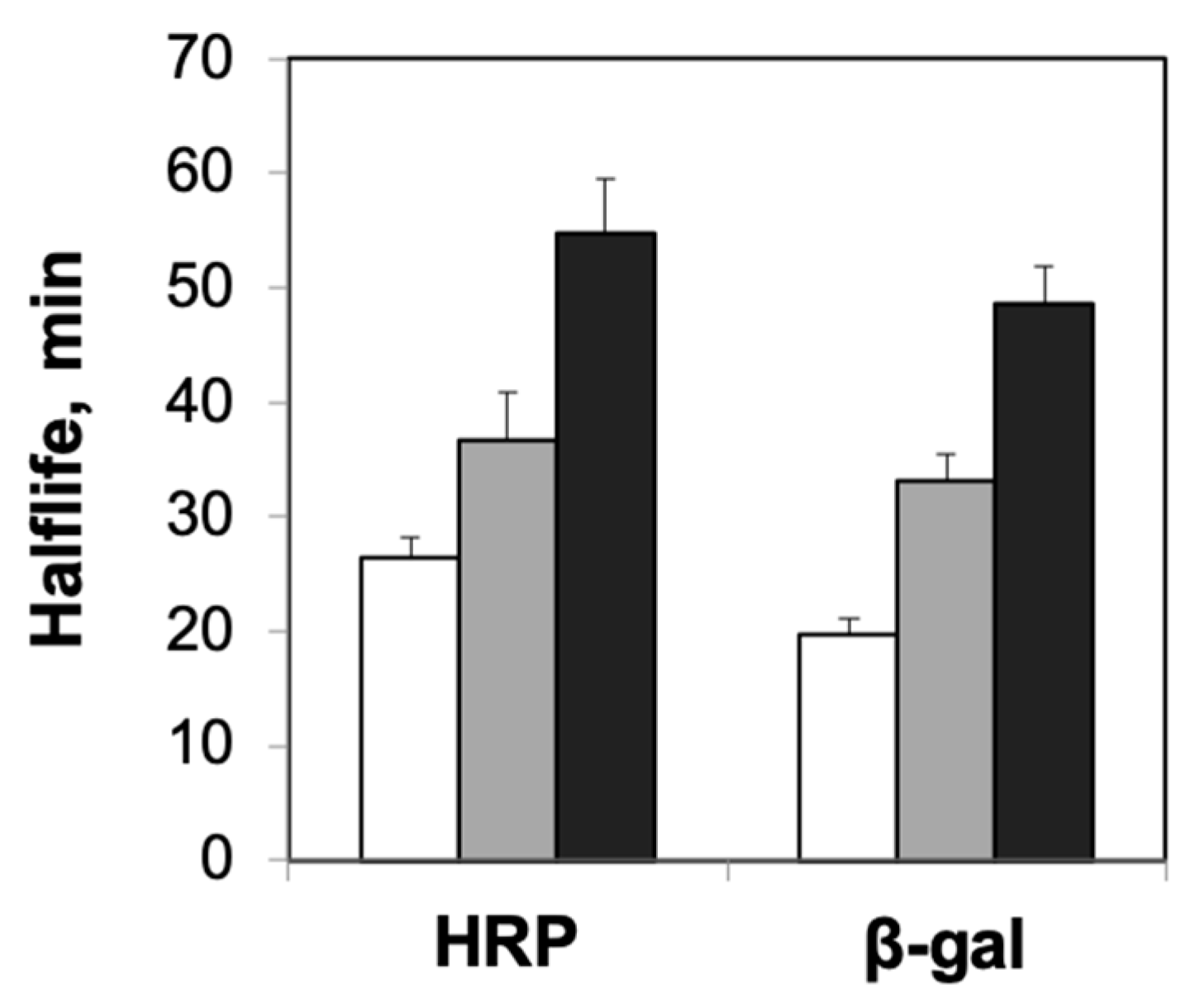
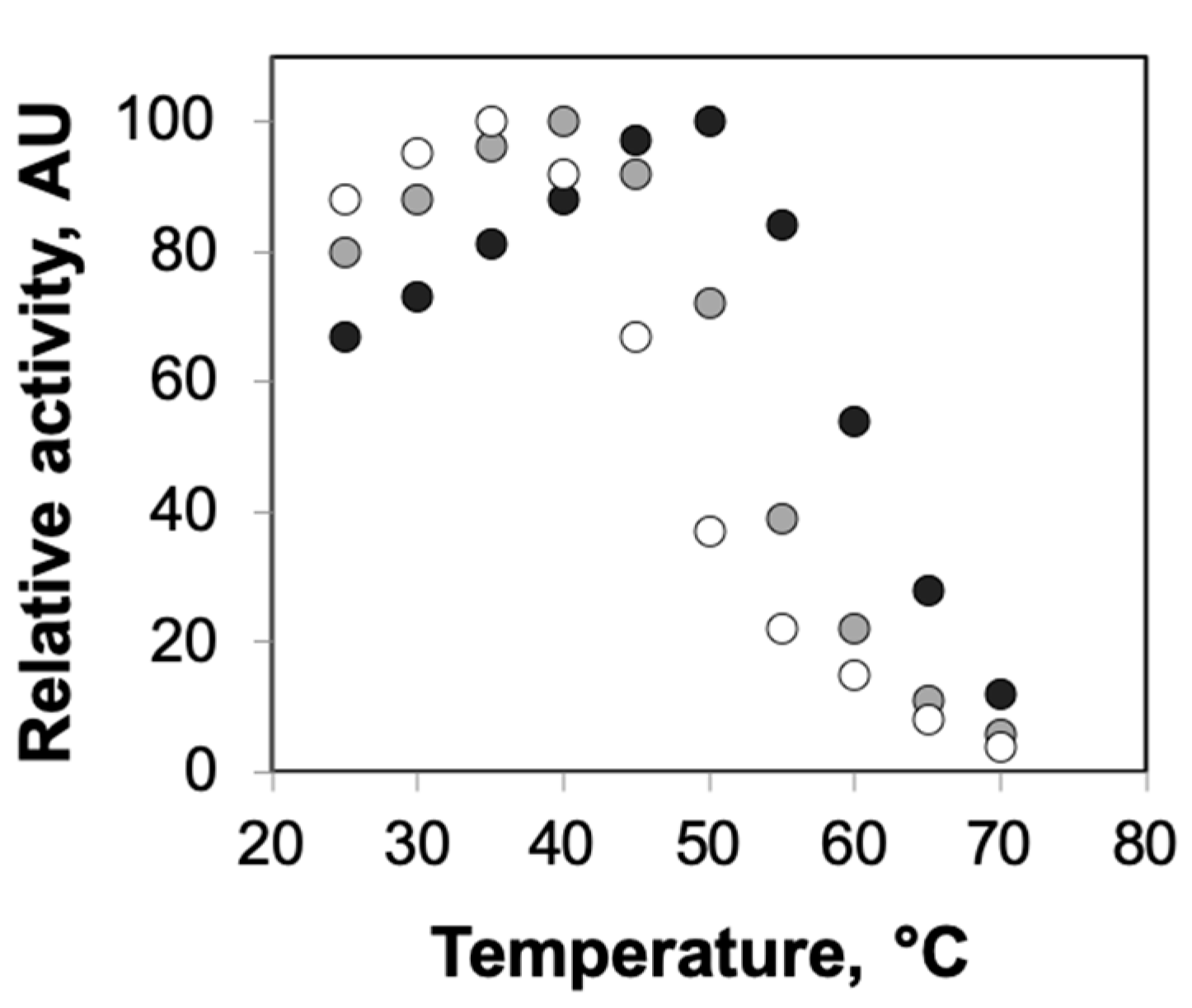
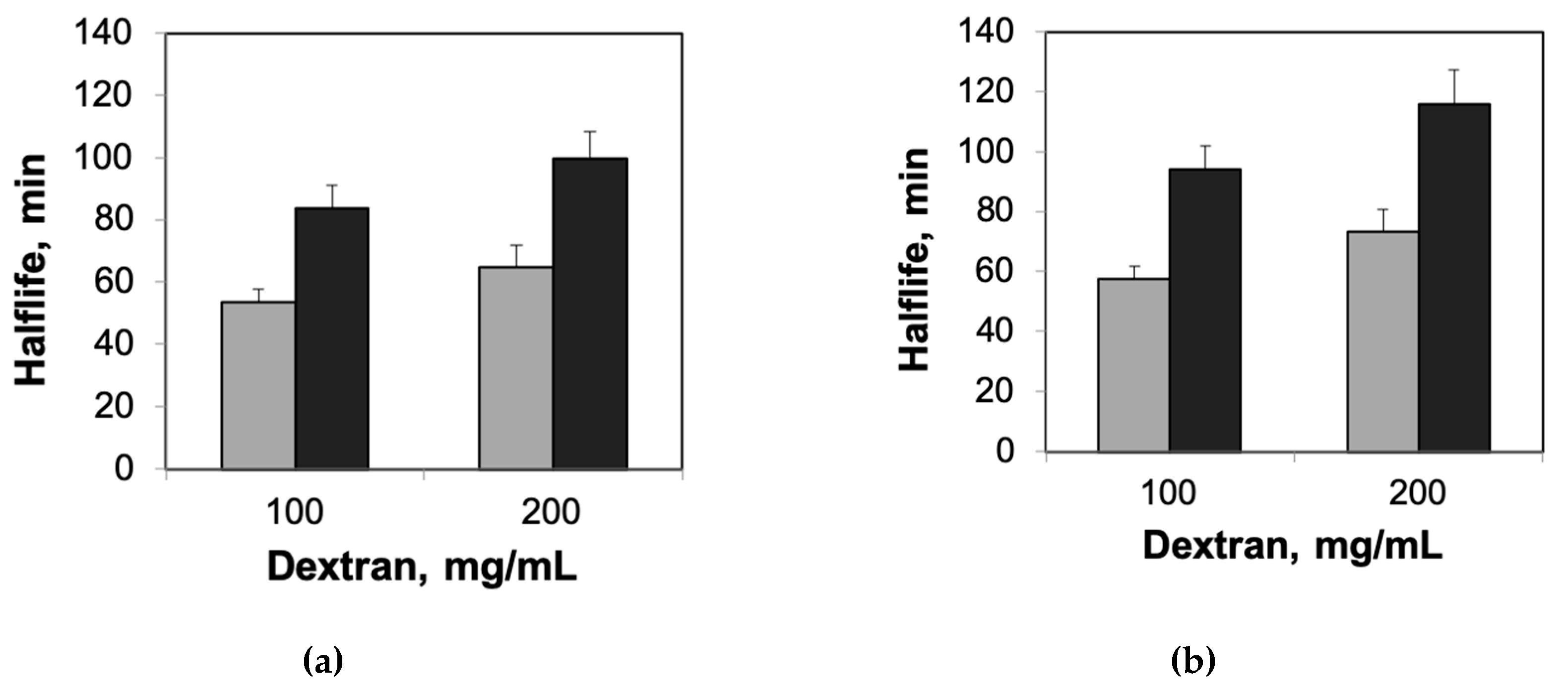
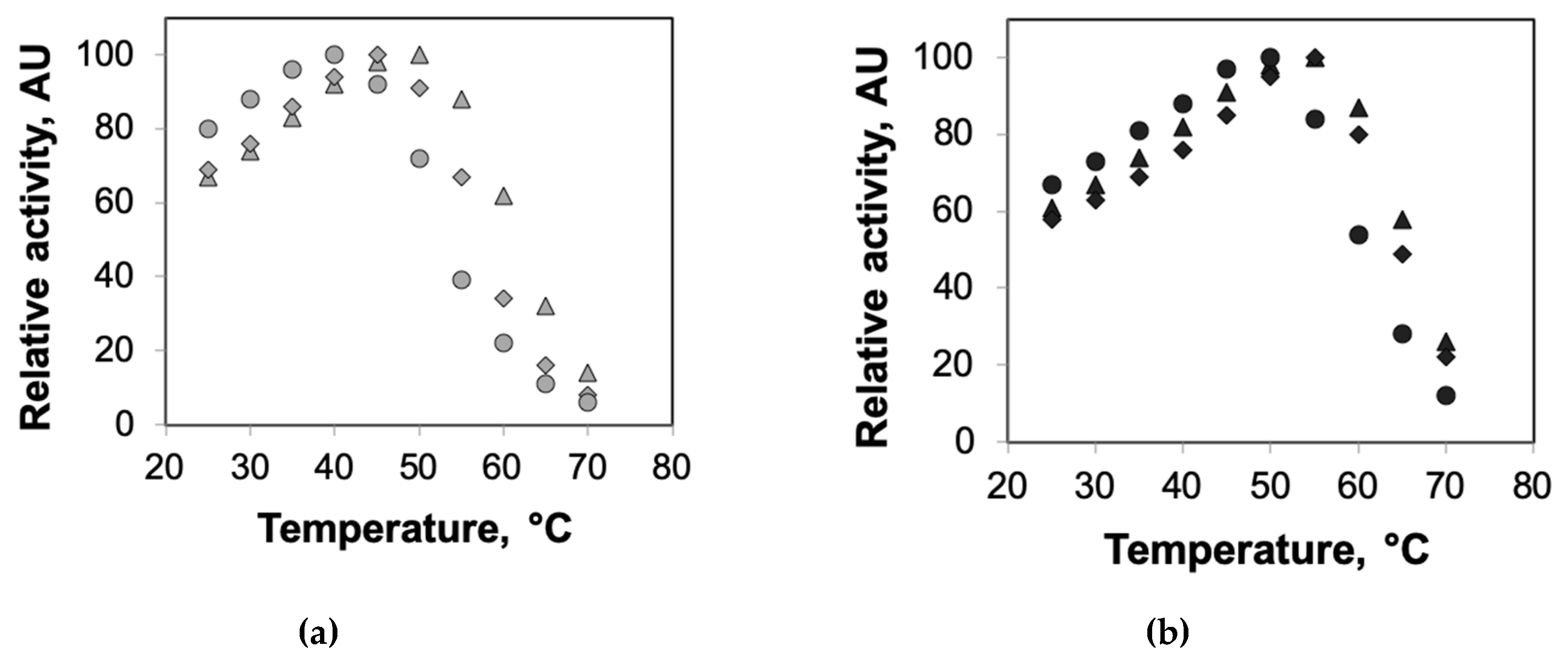
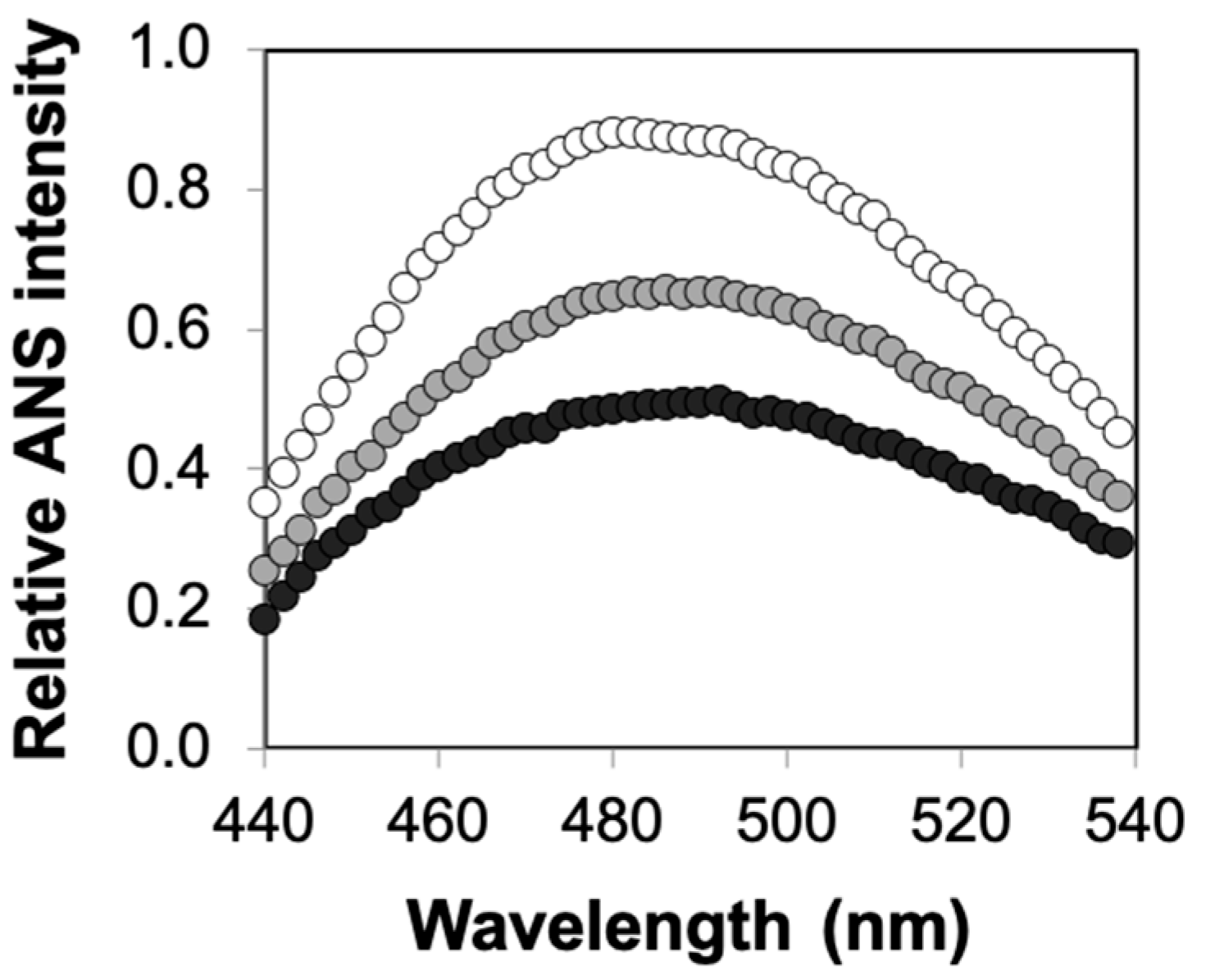
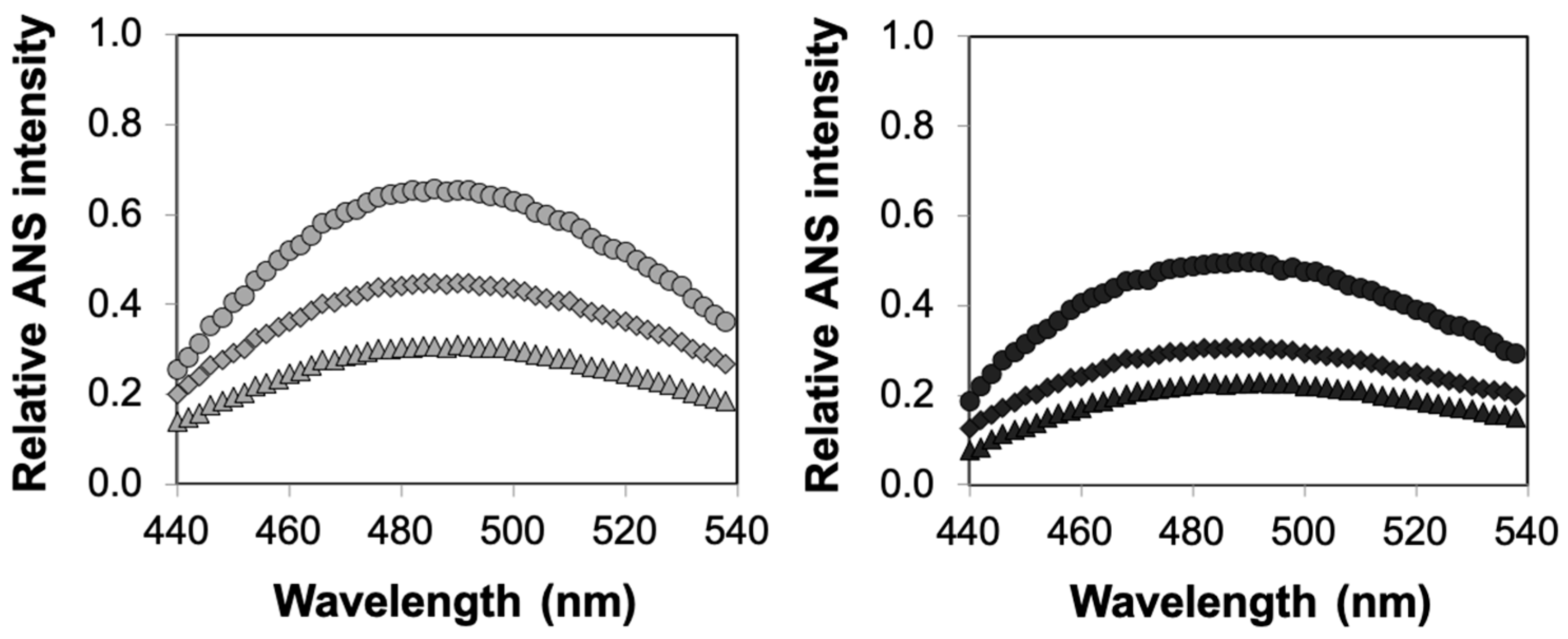
| HRP | β-gal | |||
|---|---|---|---|---|
| 100 mg/mL Dextran | 200 mg/mL Dextran | 100 mg/mL Dextran | 200 mg/mL Dextran | |
| Solution phase | 29.5 ± 4.9 | 58.3 ± 5.3 | 40.1 ± 7.6 | 76.6 ± 5.6 |
| 0.5% Agarose | 45.8 ± 6.5 | 75.2 ± 8.1 | 73.8 ± 6.3 | 120.2 ± 6.3 |
| 2% Agarose | 52.7 ± 5.8 | 81.9 ± 7.5 | 93.2 ± 8.0 | 137.4.1 ± 9.7 |
| HRP | β-gal | |||
|---|---|---|---|---|
| 100 mg/mL Dextran | 200 mg/mL Dextran | 100 mg/mL Dextran | 200 mg/mL Dextran | |
| Solution phase | 35.2 ± 4.2 | 56.1 ± 6.4 | 49.7 ± 6.1 | 91.9± 10.7 |
| 0.5% Agarose | 47.7 ± 6.5 | 90.2 ± 5.2 | 81.9 ± 7.5 | 142.5 ± 8.7 |
| 2% Agarose | 60.2 ± 5.1 | 100.2 ± 10.6 | 96.1 ± 6.8 | 150.9 ± 9.2 |
Publisher’s Note: MDPI stays neutral with regard to jurisdictional claims in published maps and institutional affiliations. |
© 2020 by the authors. Licensee MDPI, Basel, Switzerland. This article is an open access article distributed under the terms and conditions of the Creative Commons Attribution (CC BY) license (http://creativecommons.org/licenses/by/4.0/).
Share and Cite
Ross, M.L.; Kunkel, J.; Long, S.; Asuri, P. Combined Effects of Confinement and Macromolecular Crowding on Protein Stability. Int. J. Mol. Sci. 2020, 21, 8516. https://doi.org/10.3390/ijms21228516
Ross ML, Kunkel J, Long S, Asuri P. Combined Effects of Confinement and Macromolecular Crowding on Protein Stability. International Journal of Molecular Sciences. 2020; 21(22):8516. https://doi.org/10.3390/ijms21228516
Chicago/Turabian StyleRoss, Murial L., Jeffrey Kunkel, Steven Long, and Prashanth Asuri. 2020. "Combined Effects of Confinement and Macromolecular Crowding on Protein Stability" International Journal of Molecular Sciences 21, no. 22: 8516. https://doi.org/10.3390/ijms21228516
APA StyleRoss, M. L., Kunkel, J., Long, S., & Asuri, P. (2020). Combined Effects of Confinement and Macromolecular Crowding on Protein Stability. International Journal of Molecular Sciences, 21(22), 8516. https://doi.org/10.3390/ijms21228516






